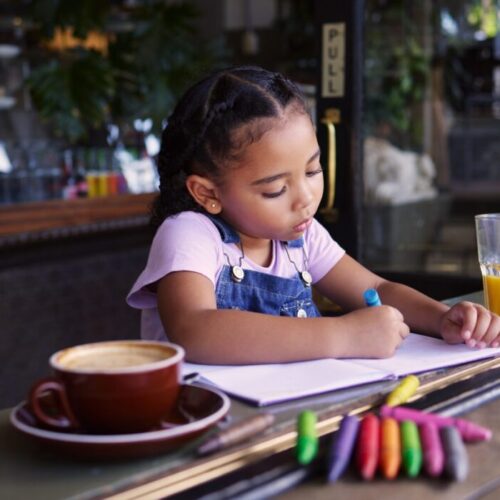Helping children navigate collective stress

In times of shared trauma, parents need tools to help children navigate emotions. Clinical psychologist Dr. Lauren Smith shares her insights with us.
As human beings, we exist within social and community networks, often seeking out emotional connections and support to develop a sense of belonging. These bonds are essential for our emotional wellbeing and help reduce any feelings of loneliness, depression and anxiety that can come our way during the ups and downs of life. Collective stress is the psychological and emotional distress experienced by a community, society or group because of a shared traumatic event or series of distressing experiences. Whether we experience these events firsthand, see or hear about the impact they are having on loved ones, or read about them in the news or on social media, it can be difficult for parents to process and make sense of these situations whilst also trying to support children in doing the same.
In the fast-paced and interconnected world we live in, children are not immune to the collective stresses that affect society at large. From global events to community challenges, the impact of these stressors can leave little ones feeling confused, anxious and overwhelmed. As parents, we feel an instinctive responsibility to provide a supportive environment that helps kids navigate these complex emotions and build resilience. This can be a hard situation to navigate as a parent and so, it’s best to have some effective tools ready at your disposal to help children in times of collective stress.
Understanding the impact
Before we delve into strategies for support, it’s important to acknowledge the impact that collective stress can have on children. Whether it’s a global pandemic, political unrest or community upheaval, children absorb the energy of their surroundings. They may not fully grasp the details of the situation, but they sense the tension, uncertainty and fear around them.
Young people often experience a range of strong emotions, such as fear, sadness, anger and confusion. In these moments, children look to the adults in their lives for guidance and reassurance, as well as to help them understand the severity of the situation and how to make sense of what is happening. This means it’s important for parents and caregivers to recognise the signs of stress in their children. Some kids may be able to vocalise their feelings and concerns, while others may show distress in their behaviour, such as having difficulty separating from parents, acting out events through play and repeatedly asking questions. These signs may also manifest as sleep disturbances or even physical complaints. By being attuned to these cues, we can proactively intervene and create a supportive framework for little ones to work through their feelings. While it may feel intuitive to try and protect young people by minimising the magnitude of the event and simply telling them that everything is okay, the first step in creating a safe space for them is to actually validate their emotions and responses in a non-judgmental way.
Open communications
Communication is the cornerstone of any healthy relationship, and this holds true in times of stress. It’s best parenting practice to create an environment where your child feels comfortable expressing their thoughts and emotions. Try to initiate conversations that encourage them to share their concerns, questions and fears, keeping in mind that children may not always have the words to articulate their feelings, so patience and open-mindedness is often needed.
When discussing challenging topics, it’s good to use age-appropriate language and concepts and avoid overwhelming kids with too much information, but rather focus on addressing their specific questions. A balance of honesty and reassurance is key here. If you don’t have all the answers, it’s okay to admit that and to then explore solutions together. Do your best to answer children’s questions in a simple and honest way, tailoring information to their developmental age, with consideration for what is appropriate for them to learn, see and hear. Younger children may need simpler explanations, while older children can engage in more complex discussions.
Routine and predictability
Children thrive on routine and predictability. During times of collective stress, maintaining a stable daily routine can provide a sorely needed sense of security. It can be useful to make a schedule that includes regular meal times, play and sleep, as consistency fosters a sense of normality for kids and helps children feel more in control of their immediate surroundings.
In addition to routine, be mindful of providing predictability in your communication. Let your child know what to expect, whether it’s changes in their routine or upcoming events. Predictability provides a different but equally important sense of stability, helping children cope with any uncertainties that may be swirling around them.
Healthy coping mechanisms
Teaching your child some healthy coping mechanisms is an excellent way to help them manage stress in all its forms. These mechanisms can include activities like drawing, journaling or physical exercise. It’s wise to encourage kids to channel their feelings through creative outlets, allowing them to process and make sense of their emotions in a format and at a pace that suits their individual tastes and feels comfortable for them, such as art, writing or other creative means.
When you can, model positive coping strategies yourself. Children are like sponges, and often learn by observing the behaviour of adults in their lives. If they see you managing stress in a healthy way, it sets a powerful example for them to follow.
Limit exposure
In today’s digital age, young people are exposed to a constant stream of information through various media channels. While it’s essential to stay informed, excessive exposure to stressful news can be detrimental, especially for young minds. It’s good to keep an eye on the amount and the type of media content your child is consuming. This way you can limit their exposure to distressing images or stories and choose age-appropriate sources of information, whilst engaging in discussions to help them understand the context. Emphasise the positive aspects of any situation, highlighting stories of resilience, compassion and community support where possible.
A sense of togetherness
Community plays a vital role in helping children feel secure during times of stress. Lean on any connections your child or your family has with friends, extended family and neighbours by organising activities that promote a sense of togetherness for your children. This could be anything from a virtual game night, to a family picnic or a small neighbourhood gathering.
By fostering a supportive community, children learn that they are not alone in facing challenges and that they have a place in which they feel they belong and are safe.
Getting help
It’s always important to recognise when the stress your child is experiencing goes beyond what you can handle alone. There is no shame in seeking professional support, whether it’s through a school counsellor, child psychologist or another qualified mental health professional. These individuals have the expertise to guide children through challenging times and provide them with the necessary tools they need to cope. As a parent, acknowledging the limits of your own understanding and seeking help when needed is a really courageous and responsible step that is often under-discussed.
It’s also essential to be mindful of your own reaction to collective stress and the care you require to manage your own wellbeing and response, and to enable you to continue to support your child. This can take on many forms and there is no single suggestion that will work for everyone. However, you may want to consider how often you’re reading the news or checking social media – there is a balance to be had between staying informed without feeling constantly confronted with highly distressing information. It’s also beneficial to try to continue to engage with activities that you know are helpful for your physical and mental health, such as exercise and seeking your own sense of connection and support from your trusted network.
In times of uncertainty, you can be pivotal in shaping how children perceive and respond to stress. By approaching the challenge bearing these tips in mind, you should be able to create a foundation for resilience in your children. Remember that each child is unique and there is no one-size-fits-all approach. Their reactions to collective stress will vary, much like ours do as adults, so it’s important to be patient and understanding as you provide support, and to adapt your approach as needed to meet your little one’s individual personality and needs.
Image Credit: Shutterstock











Comments